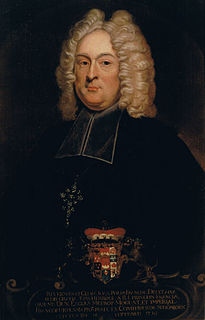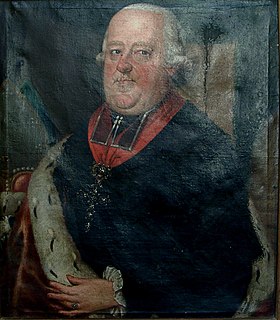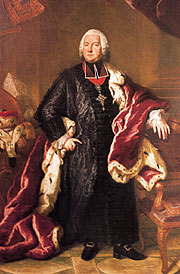
| Wikimedia Commons has media related to Adam Friedrich von Seinsheim . |
Adam Friedrich Graf von Seinsheim (1708–1779) was the Prince-Bishop of Würzburg from 1755 to 1779 and Prince-Bishop of Bamberg from 1757 to 1779.

The Prince-Bishopric of Würzburg was an ecclesiastical principality of the Holy Roman Empire located in Lower Franconia west of the Prince-Bishopric of Bamberg. Würzburg had been a diocese since 743. As definitely established by the Concordat of 1448, bishops in Germany were chosen by the canons of the cathedral chapter and their election was later confirmed by the pope. Following a common practice in Germany, the prince-bishops of Würzburg were frequently elected to other ecclesiastical principalities as well. The last few prince-bishops resided at the Würzburg Residence, which is one of the grandest baroque palaces in Europe.

The Prince-Bishopric of Bamberg was an ecclesiastical State of the Holy Roman Empire. It goes back to the Roman Catholic Diocese of Bamberg established at the 1007 synod in Frankfurt, at the behest of King Henry II to further expand the spread of Christianity in the Franconian lands. The bishops obtained the status of Imperial immediacy about 1245 and ruled their estates as Prince-bishops until they were subsumed to the Electorate of Bavaria in the course of the German Mediatisation in 1802.
Adam Friedrich von Seinsheim was born in Regensburg on 16 February 1708, the son of Maximilian Franz Graf von Seinsheim (1681-1739) and his wife Anna Philippina Gräfin von Schönborn (1685-1721). [1] His mother was the sister of Franz Georg von Schönborn, Archbishop-Elector of Trier; Friedrich Karl von Schönborn, Prince-Bishop of Bamberg and Würzburg; and Damian Hugo Philipp von Schönborn, Prince-Bishop of Speyer. [1]

Seinsheim is a municipality in the district of Kitzingen in Bavaria in Germany. It is best known for its connection with the comital Seinsheim family, which died out in 1958 with the exception of the princely House of Schwarzenberg branch of the family.

Regensburg is a city in south-east Germany, at the confluence of the Danube, Naab and Regen rivers. With more than 150,000 inhabitants, Regensburg is the fourth-largest city in the State of Bavaria after Munich, Nuremberg and Augsburg. The city is the political, economic and cultural centre and capital of the Upper Palatinate.

Graf (male) or Gräfin (female) is a historical title of the German nobility, usually translated as "count". Considered to be intermediate among noble ranks, the title is often treated as equivalent to the British title of "earl".
He became a canon of Bamberg Cathedral and Würzburg Cathedral in 1718. [1] He studied Christian theology at the University of Salzburg (master's degree 1724) and at the Collegium Germanicum 1725-27; and law at the University of Würzburg and Leiden University. [1] In 1747, he became provost of the Church of St. Gangolf in Bamberg. [1] He was ordained as a priest on 29 September 1753. [2]

A canon is a member of certain bodies subject to an ecclesiastical rule.
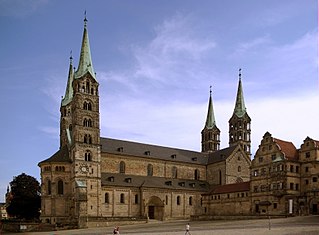
Bamberg Cathedral is a church in Bamberg, Germany, completed in the 13th century. The cathedral is under the administration of the Roman Catholic Church and is the seat of the Archbishop of Bamberg. Since 1993, the cathedral has been part of the UNESCO World Heritage Site "Town of Bamberg".

Würzburg Cathedral is a Roman Catholic cathedral in Würzburg in Bavaria, Germany, dedicated to Saint Kilian. It is the seat of the Bishop of Würzburg and has served as the burial place for the Prince-Bishops of Würzburg for hundreds of years. With an overall length of 103 metres, it is reckoned to be the fourth largest Romanesque church building in Germany, and a masterpiece of German architecture from the Salian period. Notable later additions include work by Tilman Riemenschneider and Balthasar Neumann. The cathedral was heavily damaged by British bombs in March 1945 but rebuilt post-World War II.
The cathedral chapter of Würzburg Cathedral unanimously elected him Prince-Bishop of Würzburg on 7 January 1755, with Pope Benedict XIV confirming his appointment on 17 March 1755. [2] He was consecrated as a bishop by Cardinal Franz Christoph von Hutten zu Stolzenfels, Prince-Bishop of Speyer, on 15 June 1755. [2] At the insistence of Francis I, Holy Roman Emperor, he was elected Prince-Bishop of Bamberg on 21 April 1757, thus creating a personal union between the Prince-Bishopric of Würzburg and the Prince-Bishopric of Bamberg. [1] The pope confirmed this appointment on 23 May 1757. [2]
According to both Anglican and Catholic canon law, a cathedral chapter is a college of clerics (chapter) formed to advise a bishop and, in the case of a vacancy of the episcopal see in some countries, to govern the diocese during the vacancy. These chapters are made up of canons and other officers, while in the Church of England chapters now includes a number of lay appointees; in the Roman Catholic Church their creation is the purview of the pope. They can be "numbered", in which case they are provided with a fixed "prebend", or "unnumbered", in which case the bishop indicates the number of canons according to the rents. In some Church of England cathedrals there are two such bodies, the lesser and greater chapters, which have different functions. The smaller body usually consists of the residentiary members and is included in the larger one.
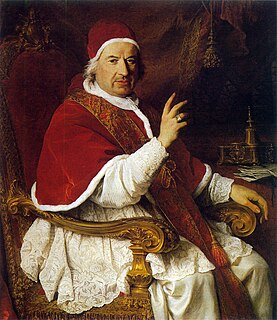
Pope Benedict XIV, born Prospero Lorenzo Lambertini, was head of the Catholic Church from 17 August 1740 to his death in 1758.

Francis I was Holy Roman Emperor and Grand Duke of Tuscany, though his wife effectively executed the real powers of those positions. With his wife, Maria Theresa, he was the founder of the Habsburg-Lorraine dynasty. From 1728 until 1737 he was Duke of Lorraine. Francis traded the duchy to the ex-Polish king Stanisław Leszczyński in exchange for the Grand Duchy of Tuscany as one of the terms ending the War of the Polish Succession in November 1738. The duchy and the ducal title to Lorraine and Bar passed to King Louis XV of France upon Leszczynski's death in 1766, though Francis and his successors retained the right to style themselves as dukes of Lorraine and Bar.
Adam Friedrich von Seinsheim supported the imperial side during the Seven Years' War. [1] Troops from the Kingdom of Prussia invaded both bishoprics during the course of this war. [1]

The Seven Years' War was a global conflict fought between 1756 and 1763. It involved every European great power of the time and spanned five continents, affecting Europe, the Americas, West Africa, India, and the Philippines. The conflict split Europe into two coalitions, led by the Kingdom of Great Britain on one side and the Kingdom of France, the Russian Empire, the Kingdom of Spain, and the Swedish Empire on the other. Meanwhile, in India, some regional polities within the increasingly fragmented Mughal Empire, with the support of the French, tried to crush a British attempt to conquer Bengal. The war's extent has led some historians to describe it as "World War Zero", similar in scale to other world wars.
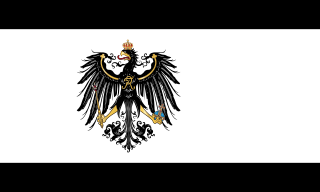
The Kingdom of Prussia was a German kingdom that constituted the state of Prussia between 1701 and 1918. It was the driving force behind the unification of Germany in 1871 and was the leading state of the German Empire until its dissolution in 1918. Although it took its name from the region called Prussia, it was based in the Margraviate of Brandenburg, where its capital was Berlin.
He died of pneumonia in Würzburg on 18 February 1779 and is buried there. [1]

Pneumonia is an inflammatory condition of the lung affecting primarily the small air sacs known as alveoli. Typically symptoms include some combination of productive or dry cough, chest pain, fever, and trouble breathing. Severity is variable.





